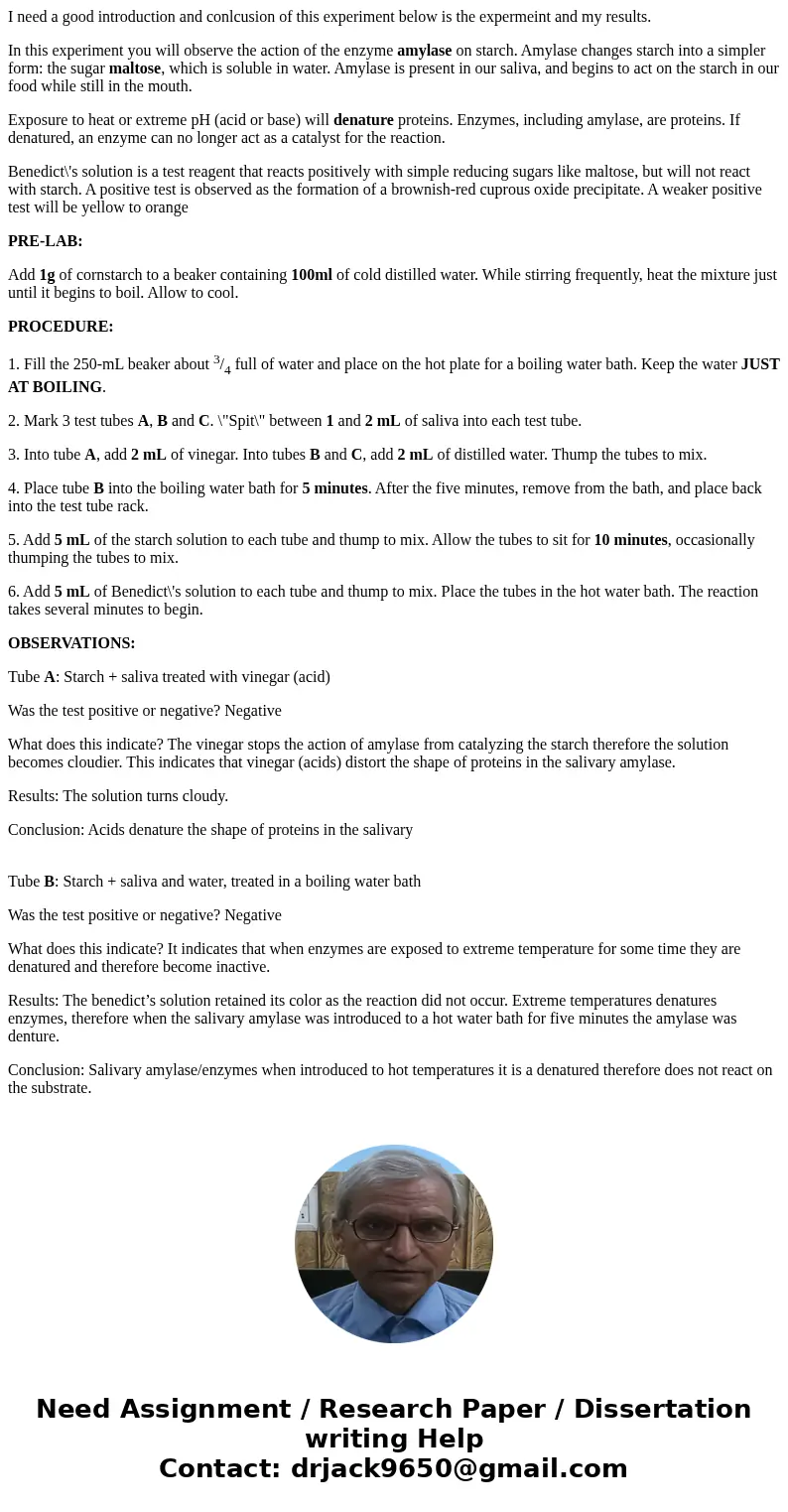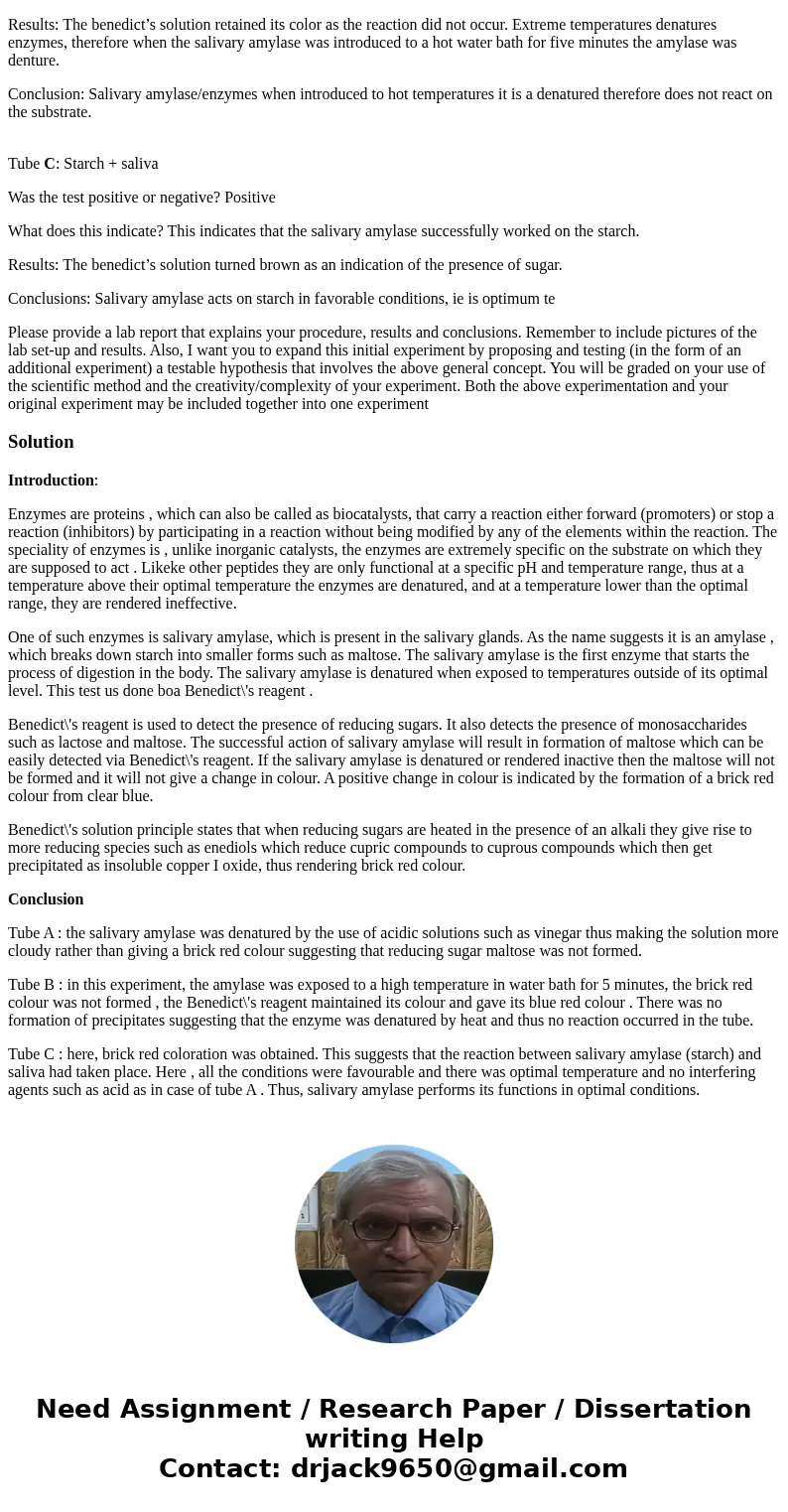I need a good introduction and conlcusion of this experiment
I need a good introduction and conlcusion of this experiment below is the expermeint and my results.
In this experiment you will observe the action of the enzyme amylase on starch. Amylase changes starch into a simpler form: the sugar maltose, which is soluble in water. Amylase is present in our saliva, and begins to act on the starch in our food while still in the mouth.
Exposure to heat or extreme pH (acid or base) will denature proteins. Enzymes, including amylase, are proteins. If denatured, an enzyme can no longer act as a catalyst for the reaction.
Benedict\'s solution is a test reagent that reacts positively with simple reducing sugars like maltose, but will not react with starch. A positive test is observed as the formation of a brownish-red cuprous oxide precipitate. A weaker positive test will be yellow to orange
PRE-LAB:
Add 1g of cornstarch to a beaker containing 100ml of cold distilled water. While stirring frequently, heat the mixture just until it begins to boil. Allow to cool.
PROCEDURE:
1. Fill the 250-mL beaker about 3/4 full of water and place on the hot plate for a boiling water bath. Keep the water JUST AT BOILING.
2. Mark 3 test tubes A, B and C. \"Spit\" between 1 and 2 mL of saliva into each test tube.
3. Into tube A, add 2 mL of vinegar. Into tubes B and C, add 2 mL of distilled water. Thump the tubes to mix.
4. Place tube B into the boiling water bath for 5 minutes. After the five minutes, remove from the bath, and place back into the test tube rack.
5. Add 5 mL of the starch solution to each tube and thump to mix. Allow the tubes to sit for 10 minutes, occasionally thumping the tubes to mix.
6. Add 5 mL of Benedict\'s solution to each tube and thump to mix. Place the tubes in the hot water bath. The reaction takes several minutes to begin.
OBSERVATIONS:
Tube A: Starch + saliva treated with vinegar (acid)
Was the test positive or negative? Negative
What does this indicate? The vinegar stops the action of amylase from catalyzing the starch therefore the solution becomes cloudier. This indicates that vinegar (acids) distort the shape of proteins in the salivary amylase.
Results: The solution turns cloudy.
Conclusion: Acids denature the shape of proteins in the salivary
Tube B: Starch + saliva and water, treated in a boiling water bath
Was the test positive or negative? Negative
What does this indicate? It indicates that when enzymes are exposed to extreme temperature for some time they are denatured and therefore become inactive.
Results: The benedict’s solution retained its color as the reaction did not occur. Extreme temperatures denatures enzymes, therefore when the salivary amylase was introduced to a hot water bath for five minutes the amylase was denture.
Conclusion: Salivary amylase/enzymes when introduced to hot temperatures it is a denatured therefore does not react on the substrate.
Tube C: Starch + saliva
Was the test positive or negative? Positive
What does this indicate? This indicates that the salivary amylase successfully worked on the starch.
Results: The benedict’s solution turned brown as an indication of the presence of sugar.
Conclusions: Salivary amylase acts on starch in favorable conditions, ie is optimum te
Please provide a lab report that explains your procedure, results and conclusions. Remember to include pictures of the lab set-up and results. Also, I want you to expand this initial experiment by proposing and testing (in the form of an additional experiment) a testable hypothesis that involves the above general concept. You will be graded on your use of the scientific method and the creativity/complexity of your experiment. Both the above experimentation and your original experiment may be included together into one experiment
Solution
Introduction:
Enzymes are proteins , which can also be called as biocatalysts, that carry a reaction either forward (promoters) or stop a reaction (inhibitors) by participating in a reaction without being modified by any of the elements within the reaction. The speciality of enzymes is , unlike inorganic catalysts, the enzymes are extremely specific on the substrate on which they are supposed to act . Likeke other peptides they are only functional at a specific pH and temperature range, thus at a temperature above their optimal temperature the enzymes are denatured, and at a temperature lower than the optimal range, they are rendered ineffective.
One of such enzymes is salivary amylase, which is present in the salivary glands. As the name suggests it is an amylase , which breaks down starch into smaller forms such as maltose. The salivary amylase is the first enzyme that starts the process of digestion in the body. The salivary amylase is denatured when exposed to temperatures outside of its optimal level. This test us done boa Benedict\'s reagent .
Benedict\'s reagent is used to detect the presence of reducing sugars. It also detects the presence of monosaccharides such as lactose and maltose. The successful action of salivary amylase will result in formation of maltose which can be easily detected via Benedict\'s reagent. If the salivary amylase is denatured or rendered inactive then the maltose will not be formed and it will not give a change in colour. A positive change in colour is indicated by the formation of a brick red colour from clear blue.
Benedict\'s solution principle states that when reducing sugars are heated in the presence of an alkali they give rise to more reducing species such as enediols which reduce cupric compounds to cuprous compounds which then get precipitated as insoluble copper I oxide, thus rendering brick red colour.
Conclusion
Tube A : the salivary amylase was denatured by the use of acidic solutions such as vinegar thus making the solution more cloudy rather than giving a brick red colour suggesting that reducing sugar maltose was not formed.
Tube B : in this experiment, the amylase was exposed to a high temperature in water bath for 5 minutes, the brick red colour was not formed , the Benedict\'s reagent maintained its colour and gave its blue red colour . There was no formation of precipitates suggesting that the enzyme was denatured by heat and thus no reaction occurred in the tube.
Tube C : here, brick red coloration was obtained. This suggests that the reaction between salivary amylase (starch) and saliva had taken place. Here , all the conditions were favourable and there was optimal temperature and no interfering agents such as acid as in case of tube A . Thus, salivary amylase performs its functions in optimal conditions.


 Homework Sourse
Homework Sourse